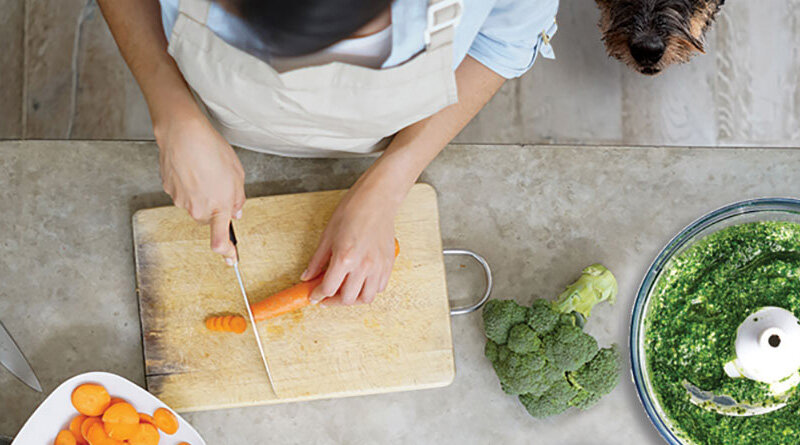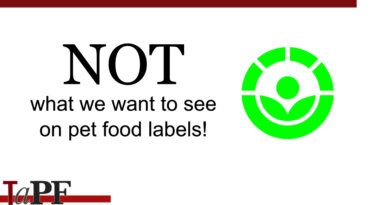Tools of the Homemade Dog Food Trade
Since I committed to the task of cooking for my dogs almost five years ago, I have been asked many questions about not just the recipes and vitamin formulations I use, but also, about my favorite kitchen tools. While you can make any of the recipes we’ve published using the simplest of tools, if you’re dedicated (as I have become) to home cooking pet food on steady basis, it does help to have equipment that makes meal prep easier—even foolproof. And of course, all of my tools do double duty, since I use them to make our meals as well.
Do keep in mind that—aside from a digital scale—you really don’t need any of these products to make delicious and nutritious dog food. The most important thing is to set aside the time it takes to learn how to make complete and balanced meals for your dog and then to do it on a regular basis.
Here’s a list of utensils, tools and appliances I have found to be most helpful and reliable as I’ve navigated my own path to better nutrition for our dogs and ourselves.
GET THE BARK IN YOUR INBOX!
Sign up for our newsletter and stay in the know.
Food Prep
Food Processor Breville BFP660SIL Sous Chef 12 Cup Food Processor
As the first step in making dog food, I roughly chop the raw larger, firm vegetables, such as sweet potatoes and carrots and fruit like apples, into rough chunks then pop the chunks into the food processor to dice them further before cooking them. This Breville model has a nice large chute feed, making that step easier. Other vegetables—green beans and brussels sprouts, for example—can be put into the processor whole to be finely processed. Having all these ingredients in small, fine-grade pieces makes blending much easier, and for the dogs, that much more digestible. I also use the food processor in the final step—combining the vegetables and grain ingredients with the meat protein—to ensure that everything is mixed well.
Mortar and Pestle Fox Run Marble Among the myriad uses for your kitchen, I rely on this mortar and pestle to grind up some of the vitamins, such as the multi-vitamins, called for in recipes.
Digital Scale Escali Primo A digital scale is not only crucial to measuring out ingredients for meal preparation, it is also invaluable in getting serving sizes spot-on each and every time. All kitchens need a digital scale!
NutriBullet or a high-speed blender Nutri-Bullet 900 Hi-Speed Blender/Mixer
I use my NutriBullet to grind seeds, such as pumpkin, sunflower and flax, and to make great smoothies for the dogs and myself.
Meat Grinder Panasonic MK-G20NR
Purchasing larger cuts of meats, such as beef and lamb, and then grinding it yourself saves both money and prep time. And, since store-bought ground meat can be highly suspect for food-borne bacteria, you’re also playing it safe to grind your own. If there’s contamination, most of it will be found on the meat’s surface, so it’s best to sear it first using a vegetable oil. The interior muscle meat is virtually sterile, as it was explained to us by a food safety expert.
Small Cooking Appliances
Because I typically make 16 pounds of dog food at a time, I use larger-sized appliances such as both an 8-quart electric pressure cooker and a 7-quart slow cooker (aka crock pot). I mostly use the pressure cooker for its quicker cooking, and while it can also function as a slow cooker. However, I find that a large, oval-shaped slow cooker to be more convenient, especially for stirring to mix up all the vegetable and grain ingredients together.
Electric Pressure Cooker Instant Pot Duo Evo Plus, 8 Qt.
Truly an invaluable kitchen appliance for everyday use. It can make oh-so-many recipes, including stock and bone broth, quickly and easily. (And you can prep chicken breasts in only 12 minutes!) This model also has a yogurt-making function.
Slow Cooker All Clad Slow Cooker 7 Qt Gourmet Slow Cooker with All-in-One Browning
One of the best features of this slow cooker is its versatility—the inside pot can be used for browning on the stovetop as well as within the cooker—and while this feature is not usually used for making dog food, it’s invaluable when making meals for the human household, such as soups and stews. It also has a really handy steamer function. I use the “low” cooking function for light cooking the vegetables and grains before blending them with the meat protein in the final step (as described in my notes on the Breville Food Processor). The glass lid makes keeping tabs easy.
Sous Vide Instant Accu Slim Sous Vide, by Instant Pot
I did a Kenji Lopez-Alt/Food Lab experiment, comparing cooking shrinkages for skinless, boneless chicken breasts, which are one of my go-to dog-food protein sources. I found that using a sous vide to prep the meat both poultry and red meat results in far less shrinkage. Cooking a chicken breast in a pressure cooker can decrease its weight by 45 percent (or more); in slow cooker, it decreases by 35 percent; but in a sous vide, it only loses 10 percent (or less).
When a recipe requires 7 pounds of cooked chicken (such as my chicken & vegetable dog food recipe), depending on which method you use, you might have to purchase more than 12 pounds of chicken to wind up with that amount. More chicken means a higher cost per serving. The other benefit of sous vide cooking is that it requires much lower heat (albeit a longer cooking time) to cook food, so more of the vitamins and nutrients are retained. This sous vide immersion circulator is one of the least expensive, entry-level models and has performed well for me.
Silicone sous vide bags Platinum Pure – Large Reusable Sous Vide Bags
One of the environmental drawbacks to the sous vide method is that you cook the food inside a air-tight plastic bag immersed in water (“sous vide” means under vacuum), and you can go through a lot of bags in the process. Better to use reusable bags, like silicone versions.
Food Storage
Making dog food in quantity requires a food-storage strategy. Most homemade dog food can be kept up to four days in the refrigerator; the rest should be frozen until needed. The most convenient way to do this is to parcel it into multi- or meal-size containers. Both glass and plastic work for these needs, but do be sure to choose BPA-free plastic.
Jars Weck Glass Jars
These beautifully designed, wide-mouth jars have many great uses, including for preserving food. But they can also be used for freezing items like leftover chicken stock or even the dog food itself. Their wide opening makes scooping the food in and out of the jar that much easier. When using the jars in a freezer, I recommend that you use the plastic lids (purchased separately) rather than the glass ones. I also use these lovely jars for making yogurt and for storing my sourdough starter and even as flower vases.
Vacuum Sealer FoodSaver FM2000 Vacuum Sealer
If freezer space is at a premium in your kitchen, you might want to store the food using this handy device. This vacuum sealer is simple and reliable and actually fun to use.
Freezer containers Cubeware 15-Pack Snap-Seal Bento Box, Meal Prep Containers These bento boxes, a take-off on traditional Japanese single-portion home-packed/take-out containers, hold 28 ounces of food. (If your prefer to store a week’s worth of food in one container, look for a large size.) As an added benefit, they can be easily stacked on a refrigerator shelf or in the freezer. They are also microwavable so you can “zap” them for a few seconds to bring the meal to room temperature, something that makes the food tastier to your dog. Also remember not to feed your dog from these containers, always best to use ceramic or stainless bowls for feeding your dog.







